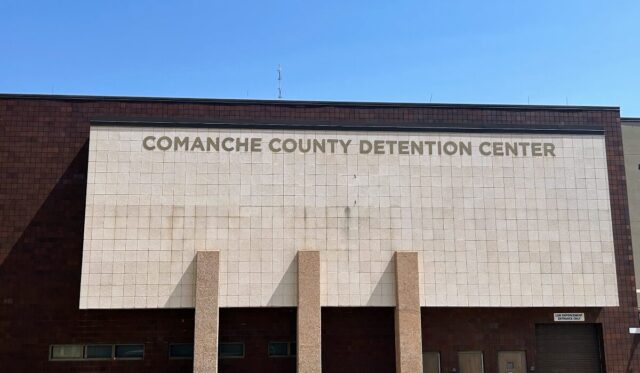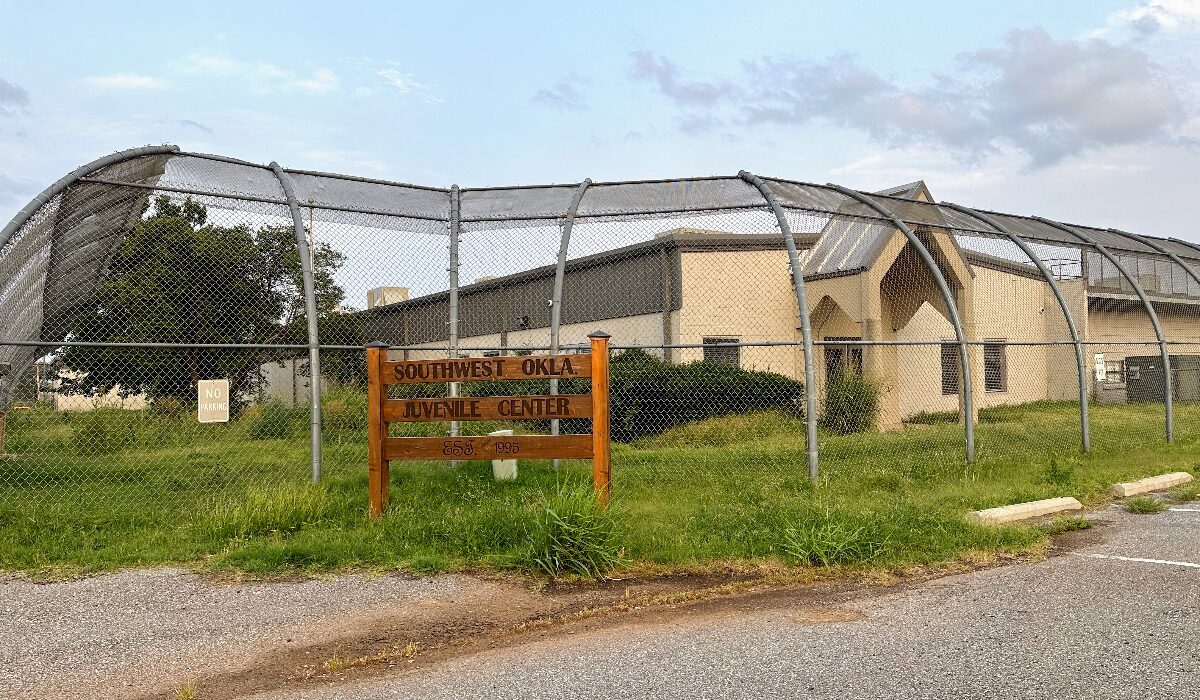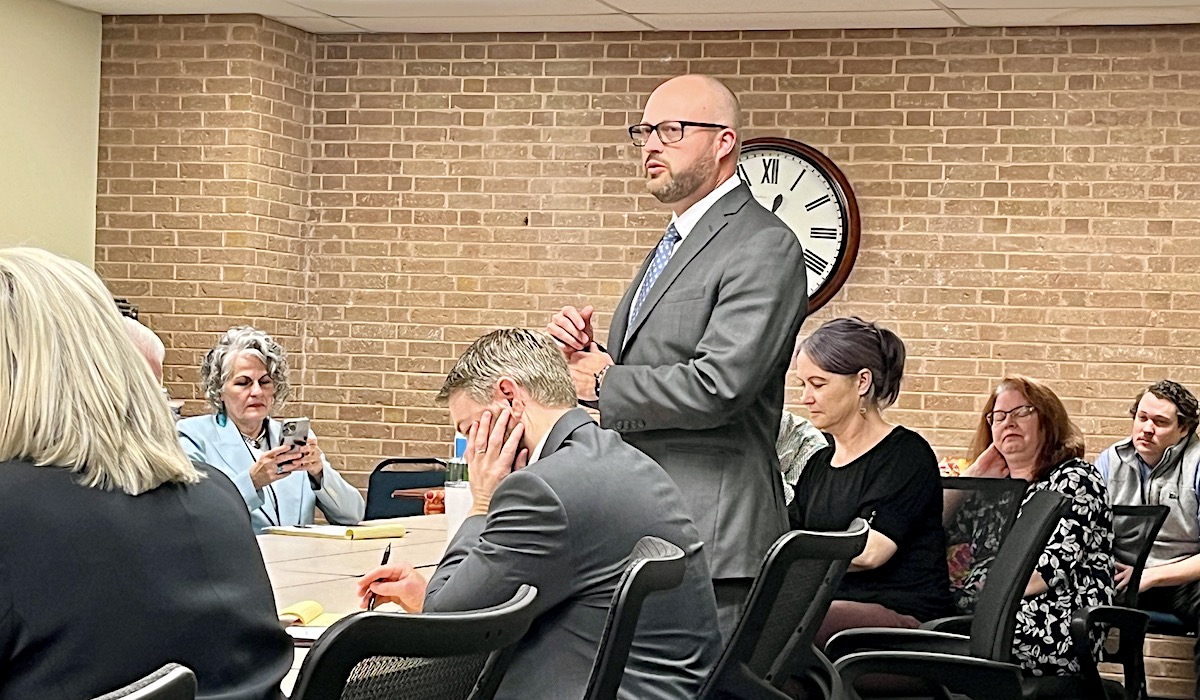

LAWTON — Despite changes in leadership and new efforts to reduce the jail population, continued overcrowding at the Comanche County Detention Center has forced officials to send some detainees as far as three hours away while conversations about building a new jail inch along.
Chronic overcrowding has caused the jail to violate a series of Oklahoma State Department of Health standards. A recent inspection report found 46 inmates sleeping on the floor of the facility, which was built in 2003.
“There’s 100 problems, and a lot are due to it being over capacity. My No. 1 priority when I came in and started looking at this was, ‘We have to get the numbers down,'” said District 3 Comanche County Commissioner Josh Powers, who took office in January 2023.
In an effort to dwindle the center’s population from 369 in June 2023 to its approved capacity of 283, he and his fellow Comanche County commissioners have entered a series of contracts with counties across the state to house detainees. However, Powers said county commissioners realize that paying other counties an average of $45 to $60 per detainee per day is not financially sustainable.
Beyond the daily costs, outsourcing jail beds to other counties causes extra travel expenses for all parties involved. Comanche County must pay transportation costs for court appearances, which are estimated at $6,756 monthly. Traveling to other counties can also cost defense attorneys and family members additional time and money.
“We do not have the funding in Comanche County to pay other counties to house all of our inmates for long term,” Powers said. “It is a short-term fix. This is us getting the problem solved for now and then moving to phase two. Basically, phase two is to come up with a long-term solution.”
One option proposed by a state representstive involves reconfiguration of the former Southwest Oklahoma Juvenile Center in Manitou, a small community 45 minutes southwest of Lawton in Tillman County. While the idea could improve the Comanche County Jail situstuon and resurrect a shuttered state facility that in Tillman County, tensions between the local commissioners have stalled discussions.
However, Comanche County District Attorney Kyle Cabelka says the crime rate and population growth in Comanche County mean the issue must be addressed sooner than later.
“It wasn’t ideal that the Department of Health shut us down during COVID-19 because it was overcrowded. The sole reason why the county is having to send people to other counties is because when the Health Department allowed us to reopen, we said that we would keep it to a certain number based on the specs that the jail was built,” Cabelka said. “That number is less than 300 inmates, but with the crime rate that we have in Comanche County, it’s not just difficult, it’s impossible, to keep that number anywhere close to it.”
County contracting and transportation costs

As of July 24, the total number of people detained by Comanche County was 375, and they were distributed among six county jails:
- Comanche County: 250;
- Okmulgee County: 68;
- Seminole County: 20
- Tillman County: 13;
- Greer County: 13; and
- Grady County: 11.
- The Okmulgee County Jail is a 368-mile round trip with a minimum travel time of six hours. The average cost of a trip is $252, and trips are made two to three times per week.
- Seminole County is a 272-mile round trip with a minimum travel time of 5 1/2 hours. The average cost of a trip is $236, and trips are made two to three times per week.
- Greer County is a 160-mile round trip with a minimum travel time of three hours. The average cost of a trip is $108, and trips are made one to two times per week.
- Grady County is a 94-mile round trip with a minimum travel time of two hours. The average cost of a trip is $62, and trips are made twice a week.
- Tillman County is a 92-mile round trip with a minimum travel time of two hours. The average cost of a trip is $62, and trips are made only when inmates are called back for court.
While the overall cost of contracts with other counties concerns the commissioners, Powers said most recent reductions in the jail population can be attributed to the agreements.
Several measures to reduce overcrowding have been listed in State Department of Health inspection reports, including transferring inmates to other jails, the use of ankle bracelets, bond reductions and early release programs.
“We have some other programs. But the problem is, a lot of our inmates are just bad and don’t qualify for some of these programs,” Powers said. “The pre-trial release program we have is kind of like a probation before you go to court. You have to check in with a probation-type officer and you’ve got to have a job, and you’ve got to meet certain qualifications to be able to do it.”
Beyond capacity issues at the jail, Comanche County officials have been concerned about other problems, including hygiene issues and missing records. OSDH “observed visible signs of uncleanliness, build-up of dirt, debris and black residue in inmate living areas” in a May inspection report.
Beyond that, a string of seven detainee deaths between August 2023 and March 2024 brought additional attention and investigations from the Oklahoma State Bureau of Investigation. The Comanche County Jail’s longtime administrator, Bill Hobbs, retired in March after 12 years leading facility.
Powers praised new jail administrator David Weber for working to reduce detainee numbers and how he has handled the transportation process to other county jails.
“(Staying at the maximum limit) allowed us to start addressing issues such as the Health Department’s issues. Because now we can move inmates around inside our facility and get those things cleaned and get all the other issues on that report taken care of, whether it’s staffing issues to recordkeeping,” Powers said. “All those things have all started to work, and I’ve seen great improvement since David Weber has taken over the jail as interim jail administrator. He’s doing a fantastic job, and he’s holding people accountable, which is a big one.”
But Weber, who was promoted July 22 from chief investigator to administrator for the Comanche County Jail, said he was not allowed to talk directly to NonDoc for this story. Instead, Powers said commissioners were only allowing communication with the administrator to run through them owing to past experiences with Hobbs speaking to media.
“He had worked there for a long time, so I mean I’m not mad at the guy, but there was definitely some things that were not being addressed properly,” Powers said of Hobbs. “He decided to go ahead and retire.”
Cabelka said the distance between the inmates in other counties and the Comanche County Courthouse has not delayed prosecution. With the exception of a jury trial where a defendant is entitled to be present in the courtroom, he said virtual alternatives can be used. Cabelka said most counties have been accommodating by allowing defendants to use programs like Microsoft Teams or Zoom to participate in court proceedings.
Still, the situation is not ideal, and Cabelka said the current Comanche County Board of Commissioners needs to have a conversation about a long-term solution.
“I think we need a bigger jail, and I’ve been pretty vocal about that with our commissioners for years,” Cabelka said.
Southwest Oklahoma Juvenile Center proposal draws drama

House Appropriations and Budget Committee Vice Chairman Trey Caldwell represents both Comanche County and Tillman County in the Oklahoma Legislature.
Aware of jail overcrowding issues in Comanche County and the negative economic impact the Southwest Oklahoma Juvenile Center’s closure had in Manitou, Caldwell has proposed repurposing SWOJC as a detention center.
“Southwest Oklahoma Juvenile Center was closed in 2022 as the result of legislation passed in 2017,” Constanzia Nizza, the chief of staff for the Oklahoma Office of Juvenile Affairs, told NonDoc in an email. “[HB 2387] authorized OJA the bonding capacity necessary to build the Next Generation campus at Central Oklahoma Juvenile Center in Tecumseh and required OJA to consolidate all secure-care operations to one campus.”
Caldwell, who has supported other plans to repurpose the center in the past, said he suggested the facility in Manitou as a possible detention center when he heard Comanche County was considering building a new jail.
“My role was really trying to take a resource we know is out there and try to get the most out of our proverbial tax dollar for Comanche County residents. That’s been my goal and aspiration,” said Caldwell (R-Lawton). “With a little bit of rehab money, you could make that facility an adult detention center. That would create 20 to 25 jobs in Tillman County, which would be a positive net gain.”
Under the two counties’ current contract, the Tillman County Jail houses Comanche County detainees for a rate of $42.50 per person per day.
“We had been housing inmates over in Tillman County for quite a while. We were doing it prior to me coming in, we usually had about 75 inmates at any day over there,” Powers said. “It was averaging out to $80,000 to $90,000 a month from Comanche County paying Tillman County. Tillman County was getting that money for housing the inmates.”
Should the Manitou facility be repurposed as an additional detention facility, Powers said the Comanche County Detention Center would remain open and functioning.
“Manitou is too far to have everybody at because we have court going on. You still want your [detainees] that are needing to see the judge on a regular basis (to be close). But the ones that have trial three or four months out, or six months out, or a year out, those could be housed in a facility that’s a little further away. That’s kind of how we prioritize the [detainees] we have right now,” Powers said. “We have some of them further away. Those are the [detainees] that have court dates that are further out, or ones that have a court date that can be done virtually, not one where they have to actually be present.”
But shortly after Comanche County representatives toured the Manitou facility, Tillman County’s commissioners passed Resolution 1732 in April to require any other county to obtain commissioners’ approval before operating a detention center within Tillman County.
The resolution, which Powers called a “selfish” attempt to block Comanche County’s use of the facility, underscored a lack of communication between the two counties’ commissioners about the idea.
“Since we have other contracts with other counties throughout the state, I directed our jail administrator to start moving our inmates to other counties that had that space available,” Powers said. “Tillman County is still on the list, but they are at the bottom of the list in priority when it comes to the placing of our inmates.”
Levi Krasser, District 3 Tillman County commissioner, confirmed that the resolution was passed in response to Comanche County’s inquiry about the use of SWOJC in Manitou.
“The reason we passed Resolution 1732 was strictly for the safety of our sheriff’s department,” Krasser said. “It’s also for the safety and protection of the constituents of Tillman County. We were just concerned about how many inmates they were bringing, what level they were bringing and how they were going to make the facility safe. That was our main concern behind this.”
While communication between the two sets of county commissioners has been lacking, Krasser said their jail administrators have spoken about the Manitou idea.
“Comanche County pulled some, not all, of their prisoners. We still have some of theirs. The ball’s kind of in their court,” Krasser said. “If something does happen, all the resolution says is, ‘Hey, just keep us in the loop on what’s going on.’ If this deal is going to happen, we want to know. Obviously it affects us.”
Powers said Tillman County is financially motivated for Comanche County to keep sending detainees to the Tillman County Jail instead of a revamped SWOJC in Manitou.
“What that is to me is that’s Tillman County commissioners trying to hold the Comanche County taxpayers hostage and keeping us from finding a better or more economical solution to our inmate housing problem,” Powers said.
Powers questioned the legality of the resolution.
“I don’t even think it’s legal because it’s property that’s in the city limits of Manitou. Our negotiation with the City of Manitou (…) doesn’t have anything to do with the county,” Powers said. “So the county commissioners may be overstepping their authority and not even having authority to block something that happens inside the corporate city limits of the town.”
Although the commissioners in both counties had yet to discuss the issue by the time of their July interviews for this article, Krasser and Powers addressed each other’s comments in interviews and emails with NonDoc.
“They already have our blessing. If they want this facility, they can do it. All we want is a seat at the table,” Krasser said July 5.
Powers responded to Krasser’s quote via email July 8 and expressed lingering irritation about the Tillman County resolution.
“As far as them having a seat at the table, our arrangements would be between Manitou and Comanche County. I am not sure if their resolution is even legal as I stated before. If they had some legitimate concerns about this, wouldn’t a call from them before they took the time to pass a board resolution seem more reasonable?” Powers said. “I’m sure at this point they can see where this all went wrong. Commissioner Joe Don Dickey, from Tillman County, contacted Rep. Trey Caldwell about their resolution before they passed it. Caldwell told me, he advised them strongly against it for this exact reason. It seems now their actions may be having some negative effects on them they did not think to calculate. If they have questions, they have my phone number and are welcome to call any time. For now we will work on a solution that does not include Tillman County.”
Despite tensions between the county officials, use of the Manitou facility is still a possibility.
“I haven’t taken the Manitou facility off of the table, but I’ve shelved it for now. I’m looking at other potential solutions,” Powers said July 3.
Powers said he is not ready to discuss the other possible solutions yet.
Dickey, a longtime influential Tillman County commissioner, said it would be best to speak with Krasser about the situation since he is currently chairman of the board.
Follow @NonDocMedia on:
Facebook | X | Text or Email
OSBI investigates Comanche County Jail deaths

At the request of local officials, the Oklahoma State Bureau of Investigation launched inquires into each of the seven inmate deaths at the Comanche County Detention Center since last July. The dates of those deaths are Aug. 23 and 24, Sept. 14, Oct. 23, Nov. 25 and March 6 and 24.
At least two of the deaths have been referenced in State Department of Health inspection reports regarding sight check violations.
“When requested, the facility did not provide sight checks for an incident occurring on Nov. 25, 2023, for review,” according to OSDH’s May 14 inspection report. “When requested, the facility did not provide facility logs denoting counts and sight checks for an incident occurring on Oct. 23, 2023, for review.”
Cabelka said he did not know why deaths increased last year at the Comanche County Jail.
“I asked myself many times over the last year and a half when these deaths were coming up, ‘Why is this happening?'” Cabelka said. “I think I could only count two or three deaths in the last 10 years that took place in our jail, and they were all natural causes.”
Cabelka filed first-degree manslaughter charges against three men — Edward Brown Sr., Markie Ishman and Calvin Riss — in the Aug. 16 death of Matthew David Jones.
“In the case that I filed, the overcrowding had nothing to do with the action of the defendants that were charged [with] killing that particular inmate,” Cabelka said. “The jail had already been sending inmates to various counties well before any of the deaths occurred.”
Investigations into some of the other deaths are still pending, he said.
“I have made decisions that there was no criminal action — it was either a suicide or death of natural causes — on, I can comfortably, say four,” Cabelka said. “Other ones are still being investigated where maybe the only thing that’s left to wait on is the actual cause of death. The most recent one, that was earlier this year, I think I’ve actually maybe cleared that one — that it was a self-inflicted suicide.”
An OSDH inspection report from June 20, 2023, found that 113 hourly checks on the suicide watch and observation sheet were missed over a nine-day period.
Cabelka said he remains unsure whether there is correlation between the Comanche County Jail’s overcrowding and its spate of deaths.
“The jail right now is not overcrowded because we have so many people in so many different counties, so I don’t know,” Cabelka said. “But like I said, on most of the deaths, I’ve either ruled them as natural causes or suicides that I don’t think would have anything to do with the actual day-to-day operations of the population of the jail.”




















